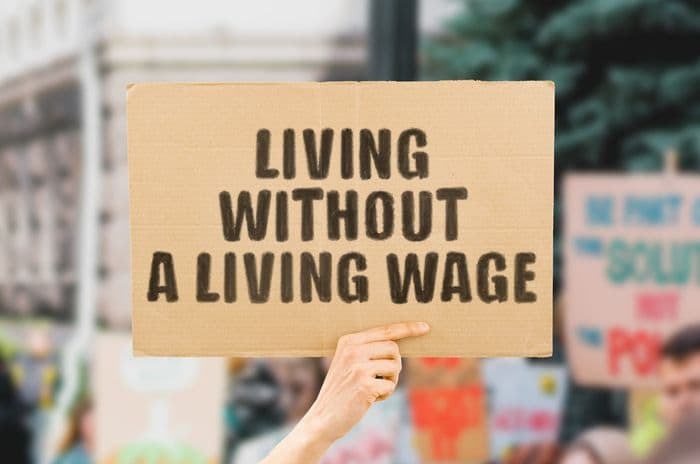Home > Money > News > A third of UK lives on unacceptable income despite wage growth
A third of UK lives on unacceptable income despite wage growth
WAGES rose faster than the rate of inflation during the last quarter of 2016, according to figures from the Office for National Statistics (ONS).

They grew at a rate of 2.6% over the three months to December, while inflation increased by only 1.6%, as measured by the Consumer Prices Index (CPI).
However, despite this encouraging growth, the Joseph Rowntree Foundation (JRF) have come out with figures of their own, which reveal that 19 million people in the UK are living on less than the Minimum Income Standard (MIS).
If nothing else, this discrepancy suggests that wage growth still isn't substantial enough to counteract the historical decline in real wages that's taken hold of the UK since the financial crisis of 2008. In addition, it also suggests that it isn't substantial enough to counteract the ongoing rise in housing expenses, which are ignored by the CPI.
Housing costs
Indeed, if nothing else, the apparent disagreement between the ONS' latest figures and those of the JRF suggest that the CPI is an inadequate measure of inflation, since it doesn't count how much people have to pay to cover their rents and mortgages.
This is why it will be replaced by the ONS in March, when the Office will begin using the CPIH, which is almost identical to the CPI except for its inclusion of housing costs associated with owning a home.
According to the ONS' own numbers, this would mean that inflation actually grew by 2%, as opposed to 1.8%.
This remains lower than wage growth, yet it still doesn't provide the entire picture, since it excludes housing costs associated with renting a home.
Such costs would bump up the rate of inflation even higher, since these grew by 2.6% in the 12 months to May 2016.
Because they grew at such a rate, they reveal how exactly the JRF could claim that 19 million people - or a third of the UK population - are living below the Minimum Income Standard despite wages having increased by a seemingly substantial degree.
Not only that, but they also reveal how the Government have been attempting to sweep the issue of housing costs under the carpet, so that they can claim people are better off, even though the shortage of affordable housing has continued to drive real living costs ever higher.
11 million 'far short'
And it's just these living costs that are being accounted for by the JRF's latest research, which found that an extra four million people are living on "inadequate" income compared to six years ago.
The measurement they used to reach this conclusion was the Minimum Income Standard. According to their own website, this is calculated by the Centre for Research in Social Policy at Loughborough University, and it's based on "what the public think is needed for a decent living standard".
This makes it somewhat more subjective than the CPI, yet at the same time it provides a more reliable indication of how people are coping with their living expenses, since it's founded on their own impressions and experiences.
And according to these, some 11 million people are living "far short" of the MIS. Up by two million since 2008/9, these are people who earn less than 75% of the standard and are in danger of falling into poverty.
The remaining eight million people represent the "just about managing" group, who aren't in any immediate trouble, but who could slip into poverty if the economic climate or their own situations take a turn for the worse.
This risk is precisely what the Bank of England alluded to at the end of last year, when Governor Mark Carney suggested that a high level of household debt and a sudden increase in unemployment or prices could send thousands of people over the financial edge.
Commenting on this possibility, JRF's chief executive, Campbell Robb, said, "The high cost of living has already helped push four million more people below an adequate income, and if the cost of essentials such as food, energy and housing rise further, we need to take action to ease the strain".
Historical decline
Yet what's interesting and worrying is not so much the threat of unemployment, but the fact that the JRF's latest figures come at a time when the employment rate is at a record high, having reached 74.6% according to ONS data.
This doesn't simply indicate that wages aren't sufficient, despite recent increases. It also indicates that too many of the jobs being added to the UK economy are temporary and part-time, as the OECD reported in 2015.
But more importantly, it also neglects the uncomfortable reality that wages still haven't fully recovered from the financial crisis of 2008, having declined by 10.4% in real terms between 2007 and 2015.
And it's this long-term decline more than anything else that explains the figures the JRF have just released, and that explains how, despite increases compared to last year, wages still have a long way to go before people can start enjoying a minimum income standard once again.
Get insider tips and the latest offers in our newsletter
Get insider tips and the latest offers in our newsletter

We are independent of all of the products and services we compare.

We order our comparison tables by price or feature and never by referral revenue.

We donate at least 5% of our profits to charity, and we aim to be climate positive.
Latest News

26 October 2022
Cost of living showing worrying trends in affordability
16 June 2022
FCA warn lenders on cost of living difficulties


